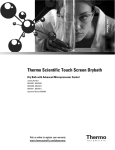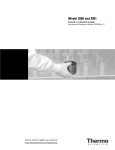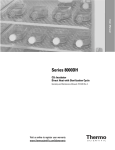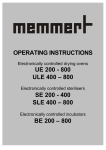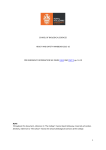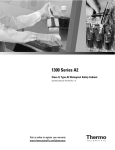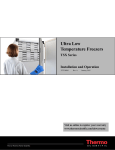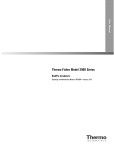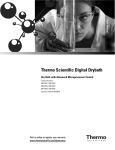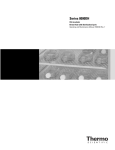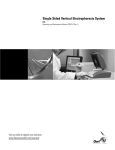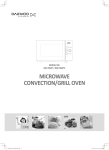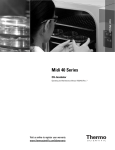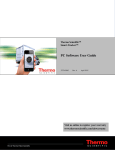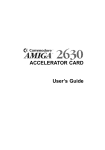Download Precision Low Temperature Incubator User Manual
Transcript
User Manual Thermo Scientific Precision Model 815 Refrigerated Incubator - Microprocessor Controlled Operating and Maintenance Manual 7013721 Rev. 0 Visit us online to register your warranty www.thermoscientific.com/labwarranty Preface Units covered in this manual: Catalog/Model Numbers Volume (L/cu. ft.) Voltage PR505755R / 3721 566/20 115 PR505750R / 3722 566/20 230 PR505750R-CN / 3722CN, 3723 566/20 230 Manual Number 7013721 0 40096 4/3/15 Original - new cabinet, cooling On/Off switch, model numbers ccs Rev ECR/ECN Date Description By Thermo Scientific Refrigerated Incubator i Preface CAUTION Contains Parts and Assemblies Susceptible to Damage by Electrostatic Discharge (ESD) Important Read this instruction manual. Failure to read, understand and follow the instructions in this manual may result in damage to the unit, injury to operating personnel, and poor equipment performance. s Caution All internal adjustments and maintenance must be performed by qualified service personnel. s Warning If the incubator is not used in the manner specified in this operating manual, the protection provided by the equipment design may be impaired. s Warning Depending on ambient temperature and settings, surface can become warm to touch (up to 60°C). s Material in this manual is for information purposes only. The contents and the product it describes are subject to change without notice. Thermo Fisher Scientific makes no representations or warranties with respect to this manual. In no event shall Thermo be held liable for any damages, direct or incidental, arising out of or related to the use of this manual. ©2015 Thermo Fisher Scientific. All rights reserved. ii Refrigerated Incubator Thermo Scientific Preface Important operating and/or maintenance instructions. Read the accompanying text carefully. Potential electrical hazards. Only qualified persons should perform procedures associated with this symbol. Equipment being maintained or serviced must be turned off and locked off to prevent possible injury. Marking of electrical and electronic equipment, which applies to electrical and electronic equipment falling under the Directive 2002/96/EC (WEEE) and the equipment that has been put on the market after 13 August 2005. This product is required to comply with the European Union’s Waste Electrical & Electronic Equipment (WEEE) Directive 2002/96/EC. It is marked with the WEEE symbol. Thermo Fisher Scientific has contracted with one or more recycling/disposal companies in each EU Member State European Country, and this product should be disposed of or recycled through them. Further information on Thermo’s compliance with this directive, the recyclers in your country and information on Thermo Scientific products will be available at www.thermoscientific.com. 4 Always use the proper protective equipment (clothing, gloves, goggles, etc.) 4 Always dissipate extreme cold or heat and wear protective clothing. 4 Always follow good hygiene practices. 4 Each individual is responsible for his or her own safety. Thermo Scientific Refrigerated Incubator iii Preface Do You Need Information or Assistance on Thermo Scientific Products? If you do, please contact us 8:00 a.m. to 6:00 p.m. (Eastern Time) at: 1-740-373-4763 1-800-438-4851 1-877-213-8051 http://www.thermoscientific.com [email protected] www.unitylabservices.com Direct Toll Free, U.S. and Canada FAX Internet Worldwide Web Home Page Tech Support Email Address Certified Service Web Page Our Sales Support staff can provide information on pricing and give you quotations. We can take your order and provide delivery information on major equipment items or make arrangements to have your local sales representative contact you. Our products are listed on the Internet and we can be contacted through our Internet home page. Our Service Support staff can supply technical information about proper setup, operation or troubleshooting of your equipment. We can fill your needs for spare or replacement parts or provide you with on-site service. We can also provide you with a quotation on our Extended Warranty for your Thermo Scientific products. Whatever Thermo Scientific products you need or use, we will be happy to discuss your applications. If you are experiencing technical problems, working together, we will help you locate the problem and, chances are, correct it yourself...over the telephone without a service call. When more extensive service is necessary, we will assist you with direct factory trained technicians or a qualified service organization for on-the-spot repair. If your service need is covered by the warranty, we will arrange for the unit to be repaired at our expense and to your satisfaction. Regardless of your needs, our professional telephone technicians are available to assist you Monday through Friday from 8:00 a.m. to 6:00 p.m. Eastern Time. Please contact us by telephone or fax. If you wish to write, our mailing address is: Thermo Fisher Scientific 401 Millcreek Road, Box 649 Marietta, OH 45750 International customers, please contact your local Thermo Scientific distributor. iv Refrigerated Incubator Thermo Scientific Preface Warranty Notes Information You Should Know Before Requesting Warranty Service • Locate the model and serial numbers. A serial tag is located on the unit itself. • For equipment service or maintenance, or with technical or special application inquiries, contact Technical Services at 1-800-438-4851 or 1-740-373-4763 (USA and Canada). Outside the USA, contact your local distributor. Repairs NOT Covered Under Warranty • Calibration of control parameters. Nominal calibrations are performed at the factory; typically ±1°C for temperature, ±1% for gases, and ±5% for humidity. Our service personnel can provide precise calibrations as a billable service at your location. Calibration after a warranty repair is covered under the warranty. • Damage resulting from use of improper quality water, chemicals or cleaning agents detrimental to equipment materials. • Service calls for improper installation or operating instructions. Corrections to any of the following are billable services: 1) electrical service connection 2) tubing connections 3) gas regulators 4) gas tanks 5) unit leveling 6) room ventilation 7) adverse ambient temperature fluctuations 8) any repair external to the unit • Damage resulting from accident, alteration, misuse, abuse, fire, flood, acts of God, or improper installation. • Repairs to parts or systems resulting from unauthorized unit modifications. • Any labor costs other than that specified during the parts and labor warranty period, which may include additional warranty on CO2 sensors, blower motors, water jackets, etc. Thermo Scientific Refrigerated Incubator v Table of Contents Thermo Scientific Section 1 Introduction . . . . . . . . . . . . . . . . . . . . . . . . . . . . . . . . . . . . . . . . . . . . . . . . .1-1 Unpacking and Damage . . . . . . . . . . . . . . . . . . . . . . . . . . . . . . . . . . .1-1 Performance Data . . . . . . . . . . . . . . . . . . . . . . . . . . . . . . . . . . . . . . .1-2 Theory of Operation . . . . . . . . . . . . . . . . . . . . . . . . . . . . . . . . . . . .1-2 General Information . . . . . . . . . . . . . . . . . . . . . . . . . . . . . . . . . . . . .1-2 Explanation of Front Panel Controls . . . . . . . . . . . . . . . . . . . . . . . . .1-3 Explanation of Auxiliary Panel . . . . . . . . . . . . . . . . . . . . . . . . . . . .1-4 Instrumentation Port . . . . . . . . . . . . . . . . . . . . . . . . . . . . . . . . . . . . .1-5 Section 2 Installation . . . . . . . . . . . . . . . . . . . . . . . . . . . . . . . . . . . . . . . . . . . . . . . . . .2-1 Safety Precautions . . . . . . . . . . . . . . . . . . . . . . . . . . . . . . . . . . . . . . .2-2 Section 3 Operation and Calibration . . . . . . . . . . . . . . . . . . . . . . . . . . . . . . . . . . . . .3-1 Section 4 Service . . . . . . . . . . . . . . . . . . . . . . . . . . . . . . . . . . . . . . . . . . . . . . . . . . . . . .4-1 Troubleshooting . . . . . . . . . . . . . . . . . . . . . . . . . . . . . . . . . . . . . . . . .4-1 Symptoms and Possible Causes . . . . . . . . . . . . . . . . . . . . . . . . . . .4-1 Possible Solutions . . . . . . . . . . . . . . . . . . . . . . . . . . . . . . . . . . . . . .4-3 Section 5 Maintenance . . . . . . . . . . . . . . . . . . . . . . . . . . . . . . . . . . . . . . . . . . . . . . . .5-1 General Cautions . . . . . . . . . . . . . . . . . . . . . . . . . . . . . . . . . . . . . . . .5-1 Section 6 Options . . . . . . . . . . . . . . . . . . . . . . . . . . . . . . . . . . . . . . . . . . . . . . . . . . . . . .6-1 RS232 . . . . . . . . . . . . . . . . . . . . . . . . . . . . . . . . . . . . . . . . . . . . . . . .6-1 Setting Up the Incubator for Communication . . . . . . . . . . . . . . . .6-2 Using the Communication . . . . . . . . . . . . . . . . . . . . . . . . . . . . . . .6-5 Setting up the Computer for Communication . . . . . . . . . . . . . . . .6-5 Section 7 Specifications . . . . . . . . . . . . . . . . . . . . . . . . . . . . . . . . . . . . . . . . . . . . . . .7-1 Section 8 Spare Parts . . . . . . . . . . . . . . . . . . . . . . . . . . . . . . . . . . . . . . . . . . . . . . . . . .8-1 Accessories . . . . . . . . . . . . . . . . . . . . . . . . . . . . . . . . . . . . . . . . . . . . .8-2 Refrigerated Incubator vi Section 1 Introduction Your satisfaction and safety are important to Thermo and a complete understanding of this unit is necessary to attain these objectives. Warning As a routine laboratory precaution, always wear safety glasses when working with this apparatus. s This product is not intended, nor can it be used, as a sterile or patient connected device. In addition, this apparatus is not designed for use in Class I, II or III locations as defined by the National Electrical Code. Warning If this equipment is not used as specified in this manual, the protection provided by the unit design may be impaired. s Unpacking and Damage Save all packing material until unit is put into service. This merchandise was carefully packed and thoroughly inspected before leaving our factory. Responsibility for safe delivery was assumed by the carrier upon acceptance of the shipment; therefore, claims for loss or damage sustained in transit must be made upon the carrier by the recipient as follows: 1. Visible Loss or Damage: Note any external evidence of loss or damage on the freight bill, or express receipt, and have it signed by the carrier's agent. Failure to adequately describe such external evidence of loss or damage may result in the carrier's refusing to honor your damage claim. The form required to file such claim will be supplied by the carrier. 2. Concealed Loss or Damage: Concealed loss or damage means loss or damage which does not become apparent until the merchandise has been unpacked and inspected. Should either occur, make a written request for inspection by carrier's agent within fifteen (15) days of the delivery date; then file a claim with the carrier since the damage is the carrier's responsibility. If you follow the above instructions carefully, we will guarantee our full support of your claim to be compensated for loss or concealed damage. Note Do not - for any reason - return this unit without first obtaining authorization. In any correspondence to Thermo, supply the nameplate data, including catalog number and serial number. s Thermo Scientific Refrigerated Incubator 1-1 Section 1 Installation and Start-Up General Information The incubator is commonly referred to as the standard model 815. The Model 815 Refrigerated Incubator has been designed to provide the ultimate in temperature control. The user is assured of dependable and precise performance through the use of microprocessor technology in the temperature control circuitry. This incubator is operable in the range of -10° to 50°C. These temperature ranges will meet a wide variety of applications, such as BOD determination, general incubation, as well as the preservation of critical materials. Performance Data Uniformity values: Set Temperature deviation temperature from set value, spatial (3 point measurement) Uniformity values: Temperature deviation from set value, spatial (27 point measurement according to DIN 12880) Temperature stability: Maximum temperature Energy difference at chamber consumption center point (1 point measurement) Heat up time / Cool down time from ambient temperature according to DIN 12880 Recovery time after door opening according to DIN 12880 -10°C ±0.8°C ±1.3°C ≤ ±0.25°C ≤ 0.3 kW ≈ 80 min ≈ 10 min +20°C ±0.5°C ±0.9°C ≤ ±0.15°C ≤ 0.6 kW N/A N/A +37°C ±0.3°C / ±0.5°C ±0.5°C / ±0.9°C ≤ ±0.10°C ≤ 0.1 kW / ≤ 0.6 kW ≈ 40 min ≈ 5 min +50°C ±0.5°C / ±0.3°C ±0.7°C / ±0.9°C ≤ ±0.15°C ≤ 0.15 kW/ ≤ 0.6 kW ≈ 70 min ≈ 11min Note The above performance figures are based upon the following operating conditions: - Ambient temperature of 22°C, ±3°C - Line voltage 115V, ±5% (115V version) and 230V, ±5% (230V version) - The following test protocols have been used: 3 point measurement test: 1 thermocouple sensor in center of each shelf - 1 shelf top position, 1 shelf lowest position, 1 shelf middle position 27 point measurement test: 9 x thermocouples on each shelf - 1 shelf top position, 1 shelf lowest position, 1 shelf middle position (based on DIN 12880) 1 point measurement test: 1 thermocouple at chamber center point (temporal temperature variation characterized by the maximum temperature difference) 1-2 Refrigerated Incubator Thermo Scientific Section 1 Installation and Start-Up Theory of Operation The refrigeration system, defrost heater, and air circulating fan are used in conjunction with a microprocessor controlled proportioning circuit to achieve sensitive temperature control. An RTD (Resistance Temperature Detector) located in the airstream senses any temperature deviation from the control point, and heat is provided proportionally to maintain the desired temperature. Regardless of what temperature is being maintained, the compressor operates continuously. This constant operation alleviates component failures associated with cycle type operation. The circulating fan provides even air distribution throughout the chamber and ensures temperature uniformity. Explanation of Front Panel Controls COOLING Heater On Lamp - Illuminates when power is applied to the heater. LED Display - Four digits used to display the actual, set, calibrated, high limit and low limit values. Indicator Lamps - There are five (5) green indicator lamps that support the parameter showing on the display. The sixth indicator is for a high or low temperature alarm condition. An internal audible alarm will also sound when this alarm indicator illuminates. Power On/Off Switch - The Power On/Off switch provides the main power to the incubator. Cooling On/Off Switch - The On/Off Cooling Switch provides better energy and temperature performance when setting a temperature greater than ambient (+5°C). When the setting temperature is greater than ambient (+5°C), set the cooling switch to “Off” position. Mute Key - This key is used to silence the internal audible alarm and to de-activate the external alarm device, if one is being used. High/Low Limit Key - This key is used to view the high or low temperature alarm setpoint. The first depression of the key selects the high limit. The second depression selects the low limit. The respective green indicator lamp will light. POWER >AMBIENT+5°C Figure 1-1. Front Panel Thermo Scientific Refrigerated Incubator 1-3 Section 1 Installation and Start-Up Explanation of Front Panel Controls (cont.) Explanation of Auxiliary Panel Set Temp/Cal Key - This key is used to view the operating setpoint temperature or calibrate the unit to a certified/traceable thermometer. The first depression of the key selects the operating setpoint and the second depression selects the calibration mode. The respective green indicator lamp will light. Enter Key - This key is used after any setpoint selection is made to enter the value into memory. Up/Down Arrow keys - These keys are used to increase or decrease the desired setpoint value. On the left side of the incubator control panel, there is an auxiliary panel which has the items shown in the illustration below. They are described as follows: 1) Fuse - This fuse is in line with the main power cord that comes into the incubator. The rating of this fuse is printed above the fuse holder. The physical size of this fuse is 5mm x 20mm. 2) Alarm Relay - This Alarm Relay output is provided to the user for the purpose of remotely monitoring the incubator in case of a high or low temperature alarm condition. This alarm relay will operate just as the audible alarm would. The contact itself is an isolated form C (normally open/normally closed) dry contact. This contact is to be used for low voltage class 2 connections only. The contact rating is 24 volts, 1.25 amps resistive. Typical usages of the output are shown below. In the above configuration, the light will illuminate whenever the unit goes into an alarm condition...High or Low. In the configuration below, the light will go off in a high or low temperature alarm condition. Warning Wiring must conform to all local electrical codes. s 1-4 Refrigerated Incubator Thermo Scientific Section 1 Installation and Start-Up Explanation of Auxiliary Panel (continued) 3) RS-232 Output (Optional Kit P/N 3166245) - This output is used for two way communications between the incubator and a personal computer. With the use of communications/modem software program, the user can record the temperature of the incubator at their selected time periods and store it in a file for use with a spreadsheet program. The user can also change the setpoint temperature from their personal computer and periodically monitor the actual temperature, setpoint temperature, and alarm status. 4) Recorder Output - This is a DC millivolt output which represents the temperature of the incubator. The recommended main use of this is with a chart recorder having an input impedance of at least 1 megohm. The scaled temperature output change is 10 millivolt/degree C. When the incubator is operating at a negative temperature, the chart recorder output is still positive. Use the chart below to relate temperature to output voltage. Located on the chart recorder printed circuit board is an offset potentiometer R3. If, for some reason, the recorder output voltage does not match the temperature as shown in the chart, this potentiometer can be used to tune it in. When connecting a chart recorder to the recorder output connector, it is recommended to use a shielded cable with the shield grounded at the chart recorder and to keep the cable short as possible. Instrumentation Port Thermo Scientific Located on the rear side of the incubator is an instrumentation port for the user to insert sensor wires, external meter leads, etc. into the chamber. The rubber plug provided must always be used in this port to insure the uniformity specifications. An extra plug is supplied for the user's convenience. Be sure to seal any gaps around the wire(s) going through the plug. Refrigerated Incubator 1-5 Section 2 Installation Use the proper lifting equipment when moving this unit. The unit’s shipping weight is 315 lbs. ((142.9kg). To assure proper ventilation, allow a minimum of 4" of clearance between the rear, top, and sides of the incubator and adjacent walls. If two or more incubators are positioned side by side, allow a minimum of 8" between cabinets. Adjust the front leveling feet of the incubator so that the front is higher than the rear. This will assist in door closing. Choose a site free from rapidly changing ambient temperature conditions. Wall mount brackets are attached to the top rear of the cabinet. Remove any packaging materials from the brackets. Rotate the brackets so they point straight out from the back. Secure in place with the included hardware. Attach brackets to wall. Figure 2-1. Brackets During Shipping Figure 2-2. Brackets During Use The power cord is the mains disconnect. Make sure the outlet and power cord are accessible at all times. Caution The incubator should not be operated in an environment where the ambient temperature exceeds 90°F as the compressor thermo-overload will be tripped and will result in a wide band control cycle of approximately ±4°C. Such cycling should not be misinterpreted as a malfunction of the electronic controls. s Radiators, air-conditioning outlets, other ventilating system outlets, and drafts can affect the operation of the incubator by a sudden inrush of air that is at a temperature different than operating conditions. Warning For personal safety, this apparatus must be properly grounded. s Thermo Scientific Refrigerated Incubator 2-1 Section 2 Calibration The power cord of this instrument is equipped with a three-prong (grounding) plug which mates with a standard three-prong (grounding) wall receptacle to minimize the possibility of electric shock hazard from this apparatus. The customer should have wall receptacle and circuit checked by a qualified electrician to verify receptacle is properly grounded. Where a two-prong wall receptacle is encountered, it is the personal responsibility and obligation of the user to have it replaced with a properly grounded three-prong wall receptacle. Warning Do not - under any circumstances - cut or remove third (ground) prong from the power cord. Do not use a two-prong adapter plug. s Determine the total amount of current presently being used by other apparatus connected to the circuit that will be used for this unit. It is critical that the added current demand and other equipment on the circuit not exceed the rating of the fuse or circuit breaker in use. Caution Be sure the power supply is the same voltage as specified on the nameplate. s When loading the incubator, a space of 1/2" must be allowed between adjacent items. This will allow maximum air circulation, which is necessary for proper temperature uniformity. The uniformity will be adversely affected if air circulation is obstructed. Liquid containers should never be placed in the incubator without covers. The evaporation of moisture within the chamber will only add frost and hasten the need for defrosting. This chamber is not self-defrosting. Excessive frost buildup on the evaporator coil located on the lower rear wall will also affect temperature uniformity. Safety Precautions 1. Do not place any explosive, combustible, or flammable materials in the chamber. 2. Do not place sealed containers in the chamber. Sealed containers, filled with materials do not provide room for expansion and can develop dangerous vapor pressure as the temperature increases. 3. Avoid spillage of liquids within the chamber. 4. Do not evaporate noxious fumes. Caution Do not store containers filled with acidic or caustic solutions, as vapors from these materials will attack the evaporator and void the warranty. s 2-2 Refrigerated Incubator Thermo Scientific Section 3 Operation and Calibration Power up by depressing the ON/OFF switch. Immediately after turning on power, all the segments of the display and all of the indicators will be on. After one second the display will show the actual temperature and the actual temperature indicator light will be lit. If the setpoint temperature is greater than the actual temperature, then the heater on lamp will be on or start to flash. If it flashes, then the actual temperature is near setpoint temperature. To display any temperature value - With the use of either the SET Temp/Cal key or the HIGH/LOW LIMIT key, any temperature value can be displayed. To view the set temperature, press the set Temp/Cal key once. The green indicator for the set temperature will light. If no other keys are pressed, within 5 seconds, the display will automatically return to the actual temperature. To view the calibrate temperature, press SET TEMP/ CAL twice while the display is showing the actual temperature. The same sequence of key operation is true for the use of the HIGH/LOW LIMIT key. To change the setpoint temperature - Press the SET TEMP/CAL key once. Then press the UP or DOWN arrow key until the desired temperature is displayed. When continuously pressing either the UP or DOWN keys, the display will begin to change rapidly. With a little practice, one will become accustomed to this. After the desired set temperature is achieved, then press the ENTER key. The display will then return to showing the actual temperature. If the ENTER key is not pressed, the expected new set temperature will not be accepted and the incubator will control at the previous set temperature. If the setpoint temperature is over ambient temperature by more than 5°C, the "compressor cooling function" isn't needed. Set the cooling switch at the “Off” position. Then the energy and temperature performance will provide better values. The incubator is calibrated at the factory for use over a wide range of temperatures. Due to the slight non-linearities in the control system, it may be necessary to make the display match a calibrated thermometer's reading, even though the difference might be only a few tenth's of a degree. Thermo Scientific Refrigerated Incubator 3-1 Section 3 Operation and Calibration The CALIBRATE key should be used ONLY to match a stable incubator's actual temperature to the calibrated thermometer. Place a calibrated thermometer or the probe of one at the center of the third shelf of the incubator. Select the SETPOINT desired. Allow the unit to run for at least an hour after it reaches the setpoint, before calibration is performed. Note If possible, place the thermometer into a liquid for stability. s To perform calibration, press the SET TEMP/CAL twice. The green calibration indicator should be lit. Then press either the UP or DOWN arrow keys to make the display match the noted thermometer reading. After the satisfied display is achieved, press the ENTER key. The display will then return to showing the newly calibrated actual temperature. To change the high temperature alarm/setpoint - After selecting a setpoint temperature, the HIGH TEMPERATURE ALARM SETPOINT automatically defaults to 1° higher than the setpoint that was entered. This 1° default difference can be overridden if desired. The following paragraph describes this. Press the HIGH/LOW LIMIT key once. The green "High Temperature Alarm/Set Point" indicator should be lit. Use the UP or DOWN arrow keys to select your limit value. Then press the ENTER key. If the HIGH LIMIT value you have selected is below the operating SETPOINT TEMPERATURE, the incubator alarm will activate. Caution If the default high temperature alarm setpoint (1°C above setpoint) is increased, the new alarm temperaure value will remain valid until power is removed from the unit (turning off the power switch, unplugging or power failure). When power is restored, the alarm setpoint will revert back to the default. s To change the low temperature alarm/setpoint - After selecting a setpoint temperature, the LOW TEMPERATURE SETPOINT automatically defaults to 1° lower than the setpoint that was entered. This 1° default difference can be overridden if desired. The following paragraph describes this. Press the High/Low Limit key twice. The green "Low Temperature Alarm/Setpoint" indicator should be lit. Use the UP or DOWN arrow keys to select your limit value. Then press the ENTER key. If the LOW LIMIT value you have selected is above the operating setpoint temperature, the incubator alarm will activate. 3-2 Refrigerated Incubator Thermo Scientific Section 3 Preventive Maintenance Caution If the default low temperature alarm setpoint (1°C above setpoint) is increased, the new alarm temperaure value will remain valid until power is removed from the unit (turning off the power switch, unplugging or power failure). When power is restored, the alarm setpoint will revert back to the default. s Note Software Version 2.00 and later has a 30 minute delay for the low and high alarm to avoid nuisance alarms caused by door openings. s Thermo Scientific Refrigerated Incubator 3-3 Section 3 Operation and Calibration PREVENTIVE MAINTENANCE Incubators Your equipment has been thoroughly tested and calibrated before shipment. Regular preventive maintenance is important to keep your VOJUfunctioning properly. The operator should perform routine cleaning and maintenance on a regular basis. For maximum performance BOEefficiency, it is recommended the unit be checked and calibrated periodically by a qualified service technician. The following is a condensed list of preventive maintenance requirements. See the specified section of the operating manual for further details. We have qualified service technicians, using NIST traceable instruments, available in many areas. For more information on Preventive Maintenance or Extended Warranties, please contact us at the number listed below. Cleaning and calibration adjustment intervals are dependent upon use, environmental conditions and accuracy required. Tips for all incubators: Do NOT use bleach or any disinfectant that has high chloros Use sterile, distilled or demineralized water. Do not use powdered gloves for tissue cultures. 401 Millcreek Road, Box 649 • Marietta, Ohio 45750 USA • 740-373-4763 USA and Canada 800-438-4851 • Telefax: 740-373-4189 • http://[email protected] Preventive Maintenance for Model 815 Incubators Refer to Manual Section 3-4 Action Daily Weekly Yearly 3 Check temperature display versus setpoints, w/ independent instrument -- Inspect door latch, hinges and door gasket seal. 3 Verify and document temp calibration, as applicable. See Calibration section. 5 Perform a complete decontamination procedure. Wipe down interior, shelves and side panels with disinfectant. Rinse everything well with sterile distilled water. Refrigerated Incubator Between experiments More frequent decontamination may be required, depending on use and environmental conditions Thermo Scientific Section 4 Service Warning Service should be performed only by qualified service personnel. Exercise care as line voltage is present in the control compartment. s If refrigeration service is required, after review of the Troubleshooting Section, contact Technical Services. In any communication with Thermo, include the model and serial numbers from both nameplates. Troubleshooting Problems encountered with any constant temperature chamber will most frequently be related to temperature control. Before proceeding with detailed troubleshooting, be certain that the Low Limit and High Limit controls are adjusted properly. If the limit controls are set too close or beyond the operating temperature, the incubator may be consistently going into alarm. This will result in erratic temperature control. First, the symptoms and possible causes will be listed for quick reference. Solutions will be suggested later. Warning Hazardous high voltage conditions exist inside the control panel. unplug line cord and turn "off" line switch before removing the cover. Only qualified electrical instrument personnel are authorized to perform troubleshooting and/or servicing. s Symptoms and Possible Causes Freeze-up or gradual drop in chamber temperature: No air circulation in chamber; inoperative fan (see Solution 1) Heater (see Solution 2) Power Supply PCB Assembly (see Solution 3) RTD Temperature Probe (see Solution 3, Step D and/or Solution 4). Side walls are getting warm: Depending on ambient temperature and the specific settings, the side walls may get warm to the touch - up to 60°C (140°F) . This is not a malfunction. This is normal due to the location of the condenser heat exchanger of the cooling system. Note that it has no impact on the specified performance of the unit. Thermo Scientific Refrigerated Incubator 4-1 Section 4 Service Symptoms and Possible Causes (continued) Temperature variations at set point (poor control): Excessive ambient temperature variations (see Solution 10) Compressor Relay failure (see Solution 12) No air circulation in chamber; inoperative fan (see Solution 1) RTD Temperature Probe Location (see Solution 5) Ice buildup on evaporator coils (see paragraph on "Defrosting") RTD Temperature probe (see Solution 3, Step D and/or Solution 4). Power Supply PCB Assembly (see Solution 3) Does not reach a high set point temperature: No air circulation in chamber; inoperative fan (see Solution 1) Low line voltage, less than 110V (see Solution 9) RTD Temperature Probe (see Solution 3, Step D and/or Solution 4). Power Supply PCB Assembly (see Solution 3) Overcharged compressor (see Solution 11) Differences between Temperature Set and Digital Temperature Readout: (see performance figures, page 3) RTD Temperature Probe (see Solution 3, Step D and/or Solution 4). Malfunctioning Power Supply PCB assembly (see Solution 3) Takes an extremely long time to reach high temperature set point: No air circulation in chamber; inoperative fan (see Solution 1) Low line voltage, less than 110V (see Solution 9) Power Supply PCB assembly (see Solution 3) Overcharged Compressor (see Solution 11) Display indicates or Malfunctioning RTD Temperature Probe (Solution 4) 4-2 Refrigerated Incubator Thermo Scientific Section 4 Service Possible Solutions 1. Inoperative Fan: Open the door. Place your hand near the grill at the top rear of the chamber and check for air circulation. If there is no air circulation, the fan motor is malfunctioning. Contact Technical Services. 2. Burned-out heater: To check this, the control panel cover must be removed. Warning Hazardous high voltage conditions exist inside control panel. Turn ‘OFF’ line switch on front panel and unplug line cord. s Remove all screws that fasten the cover. Locate nylon connector J1 on the Limit/Alarm PCB Assembly. Depress both ears on the plug housing and gently pull out the connector. With an Ohmmeter, measure the resistance between TB1-4 (Orange wire) and TB1-6 (Red wire). The proper heater resistance is 32 ohms. If heater resistance is correct, then measure between one heater lead (RED or ORANGE) and incubator ground, it must be infinity (Open). If the heater resistance check indicates an open circuit, it may or may not be open. In series with the heater is a thermal overload switch. It might be that this thermal overload is open and not the heater. To check the heater and thermal switch directly, the shelfs of the incubator and the back wall cover must be removed. Unplug heater and measure its' resistance. If the resistance is correct, check resistance between heater terminal and the heater sheath. It must be an open circuit. If the heater is good, then check the thermal overload switch. At room temperature it should be closed (0 ohms). This switch should only open at 80°C and then close at 65°C. If the heater and thermal switch are good, then the problem is directed towards the heater wires in the harness. If heater is defective, contact Technical Services. 3. Malfunctioning Power Supply PCB assembly: The Power Supply PCB Assembly has the triac (solid state AC voltage switch) on it which supplies the power to heater. This triac is "told" to operate, when need be, by the microprocessor. Thermo Scientific Refrigerated Incubator 4-3 Section 4 Service Possible Solutions (continued) There is another device known as an Optoisolator which serves as the high/low voltage isolator between the triac and the microprocessor. When the incubator starts experiencing temperature problems and/or variations, due to known controller malfunctions, these two components become prime suspects. The reason being they are under higher operating stress than other components. If the incubator starts experiencing temperature problems such as no heat, constant heat, or "creeping" upward heat, then follow the troubleshooting instructions below. These instructions require the use of a voltmeter being able to measure DC and AC voltages and preferably a digital voltmeter. Warning The following troubleshooting instructions require that power be on. only qualified service personnel should perform these procedures. s A) Remove the control cover and familiarize yourself with the power supply assembly #3176814. Locate the Triac (Q2), the Opto-isolator (U1), resistor (R4). Also locate the test point #2 (TP2). The first measurements will be DC voltage measurement, so a DC scale of at least 10 volts should be selected. Connect the negative lead to TP2. This is DC ground. Also locate the terminal block (TB1). B) This first section will be to verify the heater command is correct from the microprocessor, through the optoisolator, and through the Triac when the incubator is NOT requesting heat. The steps in this section must be followed in succession. 1. Select a setpoint temperature at least 10° below what the actual temperature is. The incubator should not be requesting heat as indicated by the "Heater On" indicator lamp on the front panel. It should not be on continuously or even flashing. 2. Measure the voltage at U1-Pin 2 with respect to TP2. It should be no less than 4 volts DC. 3. Measure the DC voltage across R4, since the incubator is not requesting heat, there should be no current flowing through this resistor, making the voltage drop equal to zero volts. 4. If the last two steps are not as stated, then most likely the CPU board is bad and should be replaced. 5. Switch the voltmeter to an "AC Volts" scale capable of reading 120 volts. 4-4 Refrigerated Incubator Thermo Scientific Section 4 Service Possible Solutions (continued) 6. Measure the voltage between U1-Pin 4 and U1-Pin 6. It should be line voltage. 110 VAC to 120 VAC. 7. If it is not, most likely the Optoisolator is bad and the power supply board will have to be replaced. 8. Measure the voltage TB1-4 (Orange wire) and TB1-6 (Red wire). It should be approximately 0 VAC. 9. If it is not, then most likely the triac is bad, and the power supply board should be replaced. C) This next section will be to verify the heater command is correct from the microprocessor, through the optoisolator, and through the Triac when the incubator is requesting heat. The steps in this section must be followed in succession. 1. Select a setpoint temperature at least 10° above what the actual temperature is. The incubator should be requesting heat as indicated by the "Heater On" indicator lamp on the front panel. It should be on continuously, not flashing. 2. Measure the voltage at U1-Pin 2 with respect to TP2. It should be no greater than 4 volts DC. 3. Measure the DC voltage across R4, since the incubator is requesting heat, there should be current flowing through this resistor, making the voltage drop equal to 3 volts ±0.5 volts. 4. If the last two steps are not as stated, then most likely the CPU board is bad and should be replaced. 5. Switch voltmeter to "AC Volts" scale capable of reading 120 volts. 6. Measure the voltage between U1-Pin 4 and U1-Pin 6. It should be less than 1 VAC. 7. If it is not, most likely the optoisolator is bad and the power supply board should be replaced. 8. Measure the voltage between TB1-4 (Orange wire) and TB1-6 (Red wire). It should be line voltage. 110 VAC to 120 VAC. 9. If it is not, then most likely the triac is bad. The power supply board should be replaced. Thermo Scientific Refrigerated Incubator 4-5 Section 4 Service Possible Solutions (continued) D) Measure RTD temperature probe resistance at the connector after unplugging it from plug J302. The resistance between contacts, at various temperatures are as follows: TEMPERATURE . . . . . . . . . . . . . .RESISTANCE 0°C . . . . . . . . . . . . . . . . . . . . . . . . . . .100 OHMS 20°C . . . . . . . . . . . . . . . . . . . . . . . . . .108 OHMS 37°C . . . . . . . . . . . . . . . . . . . . . . . . . .114 OHMS 50°C . . . . . . . . . . . . . . . . . . . . . . . . . .119 OHMS Note Only 2 of the 3 connector positions are used. 4. Malfunctioning RTD Temperature probe: The Control Board can detect if the temperature probe or the connection of the temperature probe to the circuit board is "OPEN" or "SHORTED". These two conditions are shown on the display as follows: DISPLAY . . . . . . . . . . . . . . . . . . . .CONDITION . . . . . . . . . . . . . . .OPEN CIRCUIT . . . . . . . . . . . . . .SHORT CIRCUIT Before coming to the conclusion that the probe is bad when one of these displays appear, check the connection of the probe to the circuit board. 5. RTD Temperature Sensor Probe Location: The Proper RTD location is important. The RTD is supported by the stainless steel bracket attached on the rear wall and near the top of the chamber. Two tube shaped clips securely support the RTD probe into place. The RTD must be inserted fully into its support bracket. 6. Constantly Experiencing Low temperature Alarm: If the incubator is constantly going into low temperature alarm, then most likely the setpoint temperature setting is too close to the low temperature alarm/setpoint setting. The setpoint temperature setting should be a minimum of 2° above the low temperature alarm setting. If the problem persists, then see Solution 3. 7. Constantly experiencing high temperature alarm: If the incubator is constantly going into high temperature alarm, then most likely the setpoint temperature setting is too close to the high temperature alarm/setpoint setting. The setpoint temperature setting should be a minimum of 2° below the high temperature alarm setting. If the problem persists, then see Solution 3. 4-6 Refrigerated Incubator Thermo Scientific Section 4 Service Possible Solutions (continued) Note Software version 2.00 and later has a 30 minute delay for the lowe and high alarm to avoid nuisance alarms caused by door openings. s 8. Ice buildup on evaporator coils: Excessive frost buildup is the result of the introduction of outside moisture. This may be caused by the evaporation of liquids placed in the chamber, or it may be the result of excessive opening of the door during high humidity conditions. The door gasket should also be examined for proper seal. If repairs are necessary, contact Technical Services. 9. Excessive line voltage variation: Incubator will operate satisfactorily over full temperature range (-10°C to 50°C) when line voltages vary from nominal voltage by -5% or +10%. Larger voltage variations may impair the Temperature Control. Correct as required. 10. Excessive ambient temperature variation: If the incubator is placed close to the air-conditioning outlet, hot radiators, or direct sunlight, or if the ambient temperature changes drastically, the chamber temperature will be affected. Correct as necessary. Caution The incubator should not be operated in an environment where the ambient temperature exceeds 90°F, as the compressor thermo-overload will be tripped and will result in a wide band control cycle of approximately ±4°C. Such cycling should not be misinterpreted as a malfunction of the electronic controls. 11. Overcharged compressor: This would happen only if compressor was overcharged after installation. For correct charge, see nameplate located behind lower portion of door. If unit has more charge than shown, it will not reach 50°C. Compressor must be discharged and recharged correctly. 12. The circuit design calls for continuous compressor operation. If compressor cycles "On-Off", it is an indication that the starting relay is overriding the control circuit. This may be the result of excessive (90°F) ambient temperature adjacent to the compressor, excess dirt on the compressor, or a relay malfunction. Provide additional wall clearance and/or circulation around the unit, clean compressor, or contact Technical Services. Thermo Scientific Refrigerated Incubator 4-7 Section 5 Maintenance The design of the incubator is such that periodic maintenance is kept to a minimum. No lubrication is required. The following paragraphs cover the few minor procedures necessary for continuous operation. Warning Turn off power switch and unplug line cord from power source before starting any maintenance procedure. s If the chamber needs to be cleaned, a mild soap and water solution, or bicarbonate of soda (1tbsp./gallon of water), is recommended. When the incubator is used frequently below ambient temperatures, or in any manner that increases moisture buildup within the chamber, an appropriate defrosting schedule must be determined. Defrosting is accomplished by turning the incubator off for 24 hours. Moisture will collect in the drip pan beneath the incubator. General Cautions 1) Overcharging a refrigeration system can cause excessive system pressure and can be dangerous. 2) The compressor terminal protective cover must be properly in place before applying electric power to the compressor. 3) Caution should be exercised by service personnel when servicing refrigeration system. 4) Service should be performed by a certified refrigeration technician only. Thermo Scientific Refrigerated Incubator 5-1 Section 6 RS232 Options Instructions to install and operate the RS232 option follow. 1. Remove the eight (8) screws securing the control panel. There are four (4) on the top and 2 on each of the sides. Then remove the cover by sliding it towards the front of the incubator. 2. Slide open the auxiliary panel door and locate the mounting area of the RS232 board as shown in illustration following. 3. Mount the RS232 printed circuit board assembly using the screws or standoffs provided. See illustration below. 4. Connect one end of the cable to J304 located on the left edge of the left printed circuit board (p/n 3176707). Be careful of alignment. 5. Connect the other end of the cable to the cable connector on the RS232 PCB assembly (see illustration). 6. Replace the control panel and secure with the eight (8) screws. The RS232 PCB provides a bi-directional communication port that will allow the user to monitor the performance or the change the operating valves of the incubator from a remote computer. RS232 Communication will require a communication program such as a modem program installed in your computer which will allow the storage of data within your files. The RS232 PCB utilizes one of the users computer serial ports, such as COM1 or COM2. The communication software must be configured to the selected port. The serial port is an IBM PC AT-style port. The cable that connects to it must end in a DB-25 (25-pin) male connector. The cable is a one-to-one wiring format. The pin assignments for the serial port are: Thermo Scientific PIN SIGNAL DESCRIPTION 2 TXD Serial Transmitted Data 3 RXD Serial Received Data 7 GND Signal Ground (O V) Refrigerated Incubator 6-1 Section 6 Factory Options TOP VIEW OF CONTROL PANEL 3176707 3176720 To J304 Assy, PCB, 815 CPU #3176707 Setting Up the Incubator for Communication Your incubator requires the selection of 3 parameters for communications: • Baud Rate - This is the speed of communication between the incubator and computer. Whatever is selected for the incubator must also be selected in the communication software selected to be used. • Status Update Time Interval - This is the time between information being sent from the incubator until it is received by the computer. • Status Display Type - Selection of the format of data to be sent to your computer. Read the following steps before performing any of them. It will allow you to familiarize yourself with the procedure and to determine the values you want beforehand. Note In the following setup mode, there is a five (5) second time-out feature that is active following each entry. If the five (5) seconds is exceeded, the unit will return to the normal operation mode. If the timeout occurs before the value was entered, start over. s 6-2 Refrigerated Incubator Thermo Scientific Section 6 Factory Options Set Up the Incubator for Communications (cont.) 1. With the incubator ON, simultaneously press and hold the UP and DOWN keys, then press the ENTER key. The letters will be shown in the display. A number other than 96 might be shown in the display: Choose the number appropriate for the Baud Rate desired. 3 = 300 6 = 600 12 = 1200 24 = 2400 48 = 4800 96 = 9600 Press the UP or DOWN key until the display shows your selection. Press ENTER. The baud rate has been entered. 2. The display should change to the following. Again, the number in the display might be different than 0.1, but it will have a decimal point. Choose the number appropriate for the Status Update Time Interval desired. 0.0 Minutes . . . . . . . . . . . . . . . . . . . . .No report 0.1 Minutes . . . . . . . . . . . . . . . . .Between reports 0.5 Minutes . . . . . . . . . . . . . . . . .Between reports 1.0 Minutes . . . . . . . . . . . . . . . . .Between reports 2.0 Minutes . . . . . . . . . . . . . . . .Between reports 5.0 Minutes . . . . . . . . . . . . . . . . .Between reports 10.0 Minutes . . . . . . . . . . . . . . . .Between reports 30.0 Minutes . . . . . . . . . . . . . . . .Between reports 60.0 Minutes . . . . . . . . . . . . . . . .Between reports Press the UP or DOWN key until the setpoint display shows your selection. Press ENTER. The value is entered. Thermo Scientific Refrigerated Incubator 6-3 Section 6 Factory Options Set Up the Incubator for Communications (cont.) 3. The display should have changed to the following. Again, the number in the display might be different than 1. This selection is for Status Display Type. Listed are the numbered selections with explanations and examples of the values displayed on your computer’s monitor when the incubator transmits information. 0 = Used for a raw, one-line status output suitable for importing into a spreadsheet. 1 = Used for a multi-line format with English headings with continuous screen. 2 = Used for the format as “1” but preceded by a clear screen command used by terminals or computers running terminal software. This mode overwrites the previous transmission. With Status Display Type = 0: 10 -5.0 0 Where: 10 = Actual Temperature -5.0 = Setpoint Temperature 0 = Normal With Status Display Type = 1 or 2: Actual Temperature: 10 Setpoint Temperature: -5.0 Alarm Status: Normal LOW HIGH 4. Allow the setup to time out. The incubator is now ready to communicate with your computer. 6-4 Refrigerated Incubator Thermo Scientific Section 6 Factory Options Setting up the Computer for Communication Using the Communication Your communications software will most likely have a setup routine to set the parameters listed below. These are the values the incubator is using, so the computer parameters must match accordingly. Also, you will probably have to select the “COM” serial port you chose when you connected the cable from your computer to the incubator. The software may ask what format the data is in. You should choose “ASCII”. Parameter Settings Baud Rate: Baud Rate value selected earlier in Step 1. Parity: None (0) Data Bits: Eight (8) Stop Bits: One (1) COM Port: Selected by user Format: ASCII The incubator transmits information on its RS232 port as long as the status update time interval is not “0.0.” If you start your communication software with the incubator on, most likely you will see the error(s) messages as follows: ERR ? VALUE IS READ ONLY ? ILLEGAL COMMAND Wait for the Status Update Time duration you selected to complete, and the communications will correct itself. Besides having the incubator transmit information in one of the three formats, the user can monitor other values or even change some of these from their computer. Thermo Scientific Refrigerated Incubator 6-5 Section 6 Factory Options Using the Communication (continued) The following table lists the available commands for monitoring or controlling your unit. View Command: Description: Unit: Range: Change Command A? Actual Temperature Degrees -10 to 50 Read Only T? Setpoint Temperature Degrees -10 to 50 T10 thru T50 R? Baud Rate - 0-5 R0 thru R5 S? Status Update Time - 0-8 S0 thru S8 V? EPROM Version Number - Current Rev. Read Only D? Status Display Type - 0-2 D0 thru D2 O? Display the Alarm Status - 0-2 Read Onl To View Data: If Status Update Time is “0.0” no data will automatically be displayed. To view data within a particular command code, type that command code followed by the question mark (?) symbol and then ENTER (Return). Example: To view Setpoint Temperature type: T? <CR> To Change Data: To change the value within the command type the command code followed by the new value and ENTER (Return). Example 1: To change Setpoint Temperature to 25.0°C type: T25.0 <CR> Example 2: To change Setpoint Temperature to -.8°C type: T-.8<CR> (A) Actual Temperature: The actual temperature within the incubator. (T) Setpoint Temperature: The temperature at which the user has selected the incubator to operate. 6-6 Refrigerated Incubator Thermo Scientific Section 6 Factory Options Using the Communication (continued) (R) Baud Rate: The rate at which data is transmitted between the incubator and your computer. 0 = 300 Baud 1 = 600 Baud 2 = 1200 Baud 3 = 2400 Baud 4 = 4800 Baud 5 = 9600 Baud (S) Status Update Time Interval: The time between data messages sent from the incubator to your computer. 0 = 0 Minutes, No report 1 = 0.1 Minutes (6 seconds) 2 = 0.5 Minutes (30 seconds) 3 = 1.0 Minutes 4 = 2.0 Minutes 5 = 5.0 Minutes 6 = 10.0 Minutes 7 = 30.0 Minutes 8 = 60.0 Minutes (V) EPROM Version Number: The incubator software version level. (D) Status Display Type: Selection of format that data is sent to your computer 0= Used for a raw, one-line status output suitable for importing into a spreadsheet 1 = Used for a multi-line format with English headings 2 = Used for the format as “1” but preceded by a clear screen command used by terminals or computers running terminal software. (O) Display the Alarm Status: The alarm has three (3) possible values: 0 = Normal, no alarms 1 = Low alarm 2 = High alarm Thermo Scientific Refrigerated Incubator 6-7 Section 7 Specifications Temperature Range -10°C to +50°C External dimensions D x W x H (mm/in) 787 x 864 x 1956 / 31 x 34 x 77 Internal dimensions D x W x H (mm/in) 508 x 673 x 1448 / 20 x 26.5 x 57 Chamber volume (L / cu ft) 566 / 20 Shelves (supplied / max 4/6 Shelf size W x D (mm / in) 642 x 422 / 25.3 x 16.6 Loading capacity per shelf (kg / lbs) 22.6 / 50 Weight (kg / lbs) 125 / 275 Shipping weight (kg / lbs) 143 / 315 Power line voltage (±5%) / frequency 115V / 60Hz 230V / 50/60Hz Power rating *** 650 W 650 W Max current *** 6.2 A 3.1 A 115V / Nema 5-15P 230V / Nema 6-15P Plug type Max. BTU output 2220 (650W) Access port diameter (mm / in) 30 / 1.2 30 / 1.2 Indoor use Altitude: 2,000 meters Temperature: 5°C to 40°C Humidity 80% RH at or below 31°C, decreasing linearly to 50% RH at 40°C Safety Specifications Mains Supply Fluctuations Rated Voltage ±10% Installation Category II * Pollution Degree 2** Class of Equipment I * Installation category (overvoltage category) defines the level of transient overvoltage which the instrument is designed to withstand safely. It depends on the nature of the electricity supply and its overvoltage protection means. For example, in CAT II which is the category used for instruments in installations supplied from a supply comparable to public mains such as hospital and research laboratories and most industrial laboratories, the expected transient overvoltage is 2500V for a 230V supply and 1500V for a 120V supply. ** Pollution Degree describes the amount of conductive pollution present in the operating environment. Pollution Degree 2 assumes that normally only non-conductive pollution such as dust occurs with the exception of occasional conductivity caused by condensation. *** Measured at ambient temperature of 32°C / 90°F Thermo Scientific Refrigerated Incubator 7-1 Section 8 Thermo Scientific Spare Parts DESCRIPTION PART NO. ASS'Y, PCB, DISPLAY, 815 3176815 ASS'Y, PCB, 815 CPU 3176707 ASS'Y, PCB, 815 PWR SUP 3176814 ASS'Y, PCB, 815 HI LIMIT 3176813 ASS'Y, RTD TEMP. PROBE, 100 3176738 COOLING SWITCH, POWER SWITCH 3175318 ASS'Y, CABLE, INTERFACE 3176759 FUSE KIT, 10 AMP, 115V 3167218 FUSE HOLDER KIT, 115V 3167216 FUSE HOLDER KIT, 230V 3167217 CORD W/PLUG, 115V 3178034 HARNESS, 815/818, 115V 3177651 CORD W/PLUG, 230V 3176551 HARNESS, 815/818, 230V 3177652 FUSE KIT, 5 AMP, 230V 3167219 RS232 COMMUNICATIONS OPTION 3166245 THERMAL CUTOFF SWITCH 400141 STOPPER KIT 3167215 BULB KIT 3167220 MOTOR, FAN- REAR 130630 AUTO TRANSFORMER (230V) 3174991 INS. TEMP SENSOR BRACKET 316129 BACK HARNESS 3177654 REAR COMPRESSOR COVER 1900381 Refrigerated Incubator 8-1 Section 8 Spare Parts Accessories 8-2 Refrigerated Incubator Name Part Number Glass Thermometers 3173710 RS232 Interface Kit 3166245 Digital Chart Recorder 3166207 Chart Paper (100 sheets) 3174255 Access Port Stopper 3167215 Shelf includes fall protection strip and shelf mounting grommets GT3185275 Thermo Scientific Section 9 Electrical Schematics 3176814 3176813 3176707 3176815 3176759 COOLING ON/OFF SWITCH 3176720 3176804 3177654 3175264 Thermo Scientific Refrigerated Incubator 9-1 Section 9 Electrical Schematics 3176814 3176707 3176815 3176813 WHT OR BLU 3176720 BLK OR BRN GRN OR GRN/YEL 3176759 COOLING ON/OFF SWITCH 3176804 3177654 3175264 50Hz 9-2 Refrigerated Incubator Thermo Scientific thermoscientific.com © 2014 Thermo Fisher Scientific Inc. All rights reserved. All trademarks are the property of Thermo Fisher Scientific and its subsidiaries. Specifications, terms and pricing are subject to change. Not all products are available in all countries. Please consult your local sales representative for details. Thermo Fisher Scientific 401 Millcreek Road Marietta, Ohio 45750 United States A Thermo Fisher Scientific Brand








































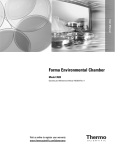
![TSD Series -40C ULT User Manual [EN]](http://vs1.manualzilla.com/store/data/005634658_1-66c9db561a67486106446026c707a26c-150x150.png)
